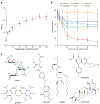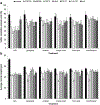Enhanced Neuronal Survival and Neurite Outgrowth Triggered by Novel Small Organic Compounds Mimicking the LewisX Glycan
- PMID: 29520715
- PMCID: PMC6314473
- DOI: 10.1007/s12035-018-0953-8
Enhanced Neuronal Survival and Neurite Outgrowth Triggered by Novel Small Organic Compounds Mimicking the LewisX Glycan
Abstract
Glycosylation fine-tunes signal transduction of adhesion molecules during neural development and supports synaptic plasticity and repair after injury in the adult nervous system. One abundantly expressed neural glycan is LewisX (LeX). Although it is known that its expression starts at the formation of the neural tube during the second embryonic week in the mouse and peaks during the first postnatal week, its functional relevance is only rudimentarily understood. To gain better insights into the functions of this glycan, we identified small organic compounds that mimic structurally and functionally this glycan glycosidically linked to several neural adhesion molecules. Mimetic compounds were identified by competitive enzyme-linked immunosorbent assay (ELISA) using the LeX-specific monoclonal antibodies L5 and SSEA-1 for screening a library of small organic molecules. In this assay, antibody binding to substrate-coated LeX glycomimetic peptide is measured in the presence of compounds, allowing identification of molecules that inhibit antibody binding and thereby mimic LeX. Gossypol, orlistat, ursolic acid, folic acid, and tosufloxacin inhibited antibody binding in a concentration-dependent manner. With the aim to functionally characterize the molecular consequences of the compounds' actions, we here present evidence that, at nM concentrations, the mimetic compounds enhance neurite outgrowth and promote neuronal survival of cultured mouse cerebellar granule cells via, notably, distinct signal transduction pathways. These findings raise hopes that these LeX mimetics will be powerful tools for further studying the functions of LeX and its effects in acute and chronic nervous system disease models. It is worth mentioning in this context that the LeX compounds investigated in the present study have been clinically approved for different therapies.
Keywords: Glycomimetic peptide; LewisX mimetics; Neurite outgrowth; Neuronal survival; Signal transduction; Small organic compounds.
Figures





Similar articles
-
Neural glycomics: the sweet side of nervous system functions.Cell Mol Life Sci. 2021 Jan;78(1):93-116. doi: 10.1007/s00018-020-03578-9. Epub 2020 Jul 1. Cell Mol Life Sci. 2021. PMID: 32613283 Free PMC article. Review.
-
The polysialic acid mimetics idarubicin and irinotecan stimulate neuronal survival and neurite outgrowth and signal via protein kinase C.J Neurochem. 2017 Aug;142(3):392-406. doi: 10.1111/jnc.14076. Epub 2017 Jun 20. J Neurochem. 2017. PMID: 28542923 Free PMC article.
-
Small Molecule Agonists of Cell Adhesion Molecule L1 Mimic L1 Functions In Vivo.Mol Neurobiol. 2016 Sep;53(7):4461-83. doi: 10.1007/s12035-015-9352-6. Epub 2015 Aug 8. Mol Neurobiol. 2016. PMID: 26253722
-
Functions of Small Organic Compounds that Mimic the HNK-1 Glycan.Int J Mol Sci. 2020 Sep 24;21(19):7018. doi: 10.3390/ijms21197018. Int J Mol Sci. 2020. PMID: 32987628 Free PMC article.
-
Systematically Studying the Effect of Small Molecules Interacting with RNA in Cellular and Preclinical Models.ACS Chem Biol. 2021 Jul 16;16(7):1111-1127. doi: 10.1021/acschembio.1c00014. Epub 2021 Jun 24. ACS Chem Biol. 2021. PMID: 34166593 Free PMC article. Review.
Cited by
-
Neural glycomics: the sweet side of nervous system functions.Cell Mol Life Sci. 2021 Jan;78(1):93-116. doi: 10.1007/s00018-020-03578-9. Epub 2020 Jul 1. Cell Mol Life Sci. 2021. PMID: 32613283 Free PMC article. Review.
-
Strategies for the Development of Glycomimetic Drug Candidates.Pharmaceuticals (Basel). 2019 Apr 11;12(2):55. doi: 10.3390/ph12020055. Pharmaceuticals (Basel). 2019. PMID: 30978966 Free PMC article. Review.
-
Glycan Mimetics from Natural Products: New Therapeutic Opportunities for Neurodegenerative Disease.Molecules. 2019 Dec 16;24(24):4604. doi: 10.3390/molecules24244604. Molecules. 2019. PMID: 31888221 Free PMC article. Review.
-
Analysis of N- and O-Linked Glycosylation: Differential Glycosylation after Rat Spinal Cord Injury.J Neurotrauma. 2020 Sep 15;37(18):1954-1962. doi: 10.1089/neu.2019.6974. Epub 2020 Jun 26. J Neurotrauma. 2020. PMID: 32316850 Free PMC article.
-
Ursolic acid and rosmarinic acid ameliorate alterations in hippocampal neurogenesis and social memory induced by amyloid beta in mouse model of Alzheimer's disease.Front Pharmacol. 2022 Dec 22;13:1058358. doi: 10.3389/fphar.2022.1058358. eCollection 2022. Front Pharmacol. 2022. PMID: 36618920 Free PMC article.
References
-
- Kruse J, Keilhauer G, Faissner A et al. (1985)The J1 glycoprotein—a novel nervous system cell adhesion molecule of the L2/HNK-1 family. Nature 316:146–148 - PubMed
MeSH terms
Substances
Grants and funding
LinkOut - more resources
Full Text Sources
Other Literature Sources

